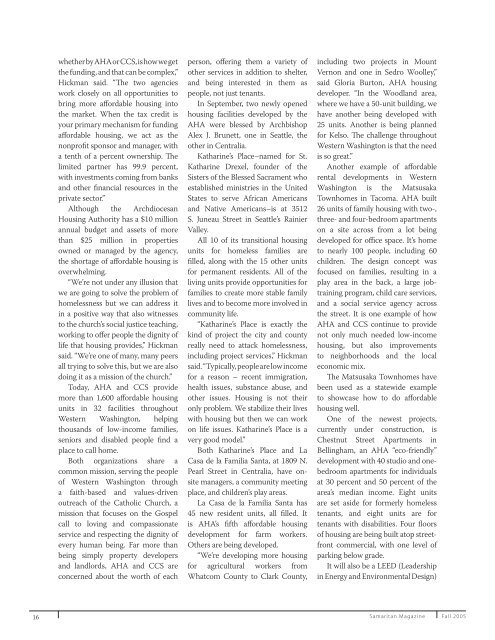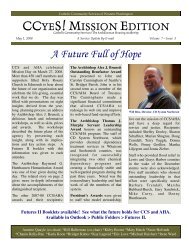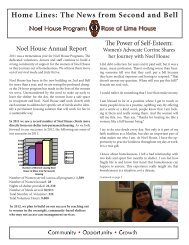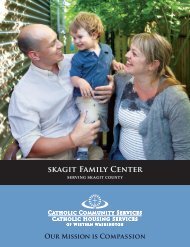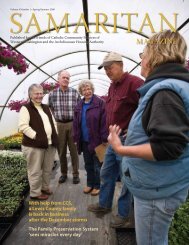Affordable Housing - Catholic Community Services
Affordable Housing - Catholic Community Services
Affordable Housing - Catholic Community Services
You also want an ePaper? Increase the reach of your titles
YUMPU automatically turns print PDFs into web optimized ePapers that Google loves.
whether by AHA or CCS, is how we get<br />
the funding, and that can be complex,”<br />
Hickman said. “The two agencies<br />
work closely on all opportunities to<br />
bring more affordable housing into<br />
the market. When the tax credit is<br />
your primary mechanism for funding<br />
affordable housing, we act as the<br />
nonprofit sponsor and manager, with<br />
a tenth of a percent ownership. The<br />
limited partner has 99.9 percent,<br />
with investments coming from banks<br />
and other financial resources in the<br />
private sector.”<br />
Although the Archdiocesan<br />
<strong>Housing</strong> Authority has a $10 million<br />
annual budget and assets of more<br />
than $25 million in properties<br />
owned or managed by the agency,<br />
the shortage of affordable housing is<br />
overwhelming.<br />
“We’re not under any illusion that<br />
we are going to solve the problem of<br />
homelessness but we can address it<br />
in a positive way that also witnesses<br />
to the church’s social justice teaching,<br />
working to offer people the dignity of<br />
life that housing provides,” Hickman<br />
said. “We’re one of many, many peers<br />
all trying to solve this, but we are also<br />
doing it as a mission of the church.”<br />
Today, AHA and CCS provide<br />
more than 1,600 affordable housing<br />
units in 32 facilities throughout<br />
Western Washington, helping<br />
thousands of low-income families,<br />
seniors and disabled people find a<br />
place to call home.<br />
Both organizations share a<br />
common mission, serving the people<br />
of Western Washington through<br />
a faith-based and values-driven<br />
outreach of the <strong>Catholic</strong> Church, a<br />
mission that focuses on the Gospel<br />
call to loving and compassionate<br />
service and respecting the dignity of<br />
every human being. Far more than<br />
being simply property developers<br />
and landlords, AHA and CCS are<br />
concerned about the worth of each<br />
person, offering them a variety of<br />
other services in addition to shelter,<br />
and being interested in them as<br />
people, not just tenants.<br />
In September, two newly opened<br />
housing facilities developed by the<br />
AHA were blessed by Archbishop<br />
Alex J. Brunett, one in Seattle, the<br />
other in Centralia.<br />
Katharine’s Place–named for St.<br />
Katharine Drexel, founder of the<br />
Sisters of the Blessed Sacrament who<br />
established ministries in the United<br />
States to serve African Americans<br />
and Native Americans–is at 3512<br />
S. Juneau Street in Seattle’s Rainier<br />
Valley.<br />
All 10 of its transitional housing<br />
units for homeless families are<br />
filled, along with the 15 other units<br />
for permanent residents. All of the<br />
living units provide opportunities for<br />
families to create more stable family<br />
lives and to become more involved in<br />
community life.<br />
“Katharine’s Place is exactly the<br />
kind of project the city and county<br />
really need to attack homelessness,<br />
including project services,” Hickman<br />
said. “Typically, people are low income<br />
for a reason – recent immigration,<br />
health issues, substance abuse, and<br />
other issues. <strong>Housing</strong> is not their<br />
only problem. We stabilize their lives<br />
with housing but then we can work<br />
on life issues. Katharine’s Place is a<br />
very good model.”<br />
Both Katharine’s Place and La<br />
Casa de la Familia Santa, at 1809 N.<br />
Pearl Street in Centralia, have onsite<br />
managers, a community meeting<br />
place, and children’s play areas.<br />
La Casa de la Familia Santa has<br />
45 new resident units, all filled. It<br />
is AHA’s fifth affordable housing<br />
development for farm workers.<br />
Others are being developed.<br />
“We’re developing more housing<br />
for agricultural workers from<br />
Whatcom County to Clark County,<br />
including two projects in Mount<br />
Vernon and one in Sedro Woolley,”<br />
said Gloria Burton, AHA housing<br />
developer. “In the Woodland area,<br />
where we have a 50-unit building, we<br />
have another being developed with<br />
25 units. Another is being planned<br />
for Kelso. The challenge throughout<br />
Western Washington is that the need<br />
is so great.”<br />
Another example of affordable<br />
rental developments in Western<br />
Washington is the Matsusaka<br />
Townhomes in Tacoma. AHA built<br />
26 units of family housing with two-,<br />
three- and four-bedroom apartments<br />
on a site across from a lot being<br />
developed for office space. It’s home<br />
to nearly 100 people, including 60<br />
children. The design concept was<br />
focused on families, resulting in a<br />
play area in the back, a large jobtraining<br />
program, child care services,<br />
and a social service agency across<br />
the street. It is one example of how<br />
AHA and CCS continue to provide<br />
not only much needed low-income<br />
housing, but also improvements<br />
to neighborhoods and the local<br />
economic mix.<br />
The Matsusaka Townhomes have<br />
been used as a statewide example<br />
to showcase how to do affordable<br />
housing well.<br />
One of the newest projects,<br />
currently under construction, is<br />
Chestnut Street Apartments in<br />
Bellingham, an AHA “eco-friendly”<br />
development with 40 studio and onebedroom<br />
apartments for individuals<br />
at 30 percent and 50 percent of the<br />
area’s median income. Eight units<br />
are set aside for formerly homeless<br />
tenants, and eight units are for<br />
tenants with disabilities. Four floors<br />
of housing are being built atop streetfront<br />
commercial, with one level of<br />
parking below grade.<br />
It will also be a LEED (Leadership<br />
in Energy and Environmental Design)<br />
16 Samaritan Magazine Fall 2005


